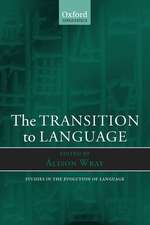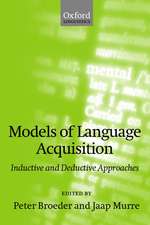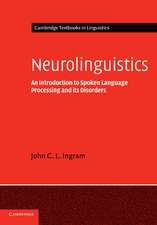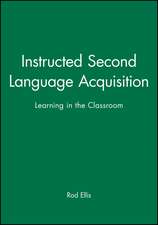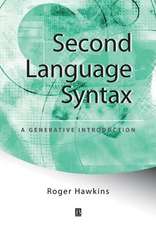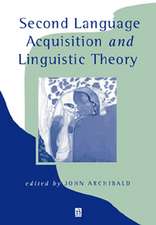Psycholinguistic Approaches to Meaning and Understanding across Languages: Studies in Theoretical Psycholinguistics, cartea 44
Editat de Barbara Hemforth, Barbara Mertins, Cathrine Fabricius-Hansenen Limba Engleză Hardback – 16 iul 2014
| Toate formatele și edițiile | Preț | Express |
|---|---|---|
| Paperback (1) | 638.76 lei 6-8 săpt. | |
| Springer International Publishing – 17 sep 2016 | 638.76 lei 6-8 săpt. | |
| Hardback (1) | 644.95 lei 6-8 săpt. | |
| Springer International Publishing – 16 iul 2014 | 644.95 lei 6-8 săpt. |
Din seria Studies in Theoretical Psycholinguistics
- 18%
 Preț: 948.61 lei
Preț: 948.61 lei - 18%
 Preț: 1222.31 lei
Preț: 1222.31 lei - 15%
 Preț: 641.53 lei
Preț: 641.53 lei - 18%
 Preț: 947.50 lei
Preț: 947.50 lei - 15%
 Preț: 645.79 lei
Preț: 645.79 lei -
 Preț: 381.81 lei
Preț: 381.81 lei - 18%
 Preț: 2103.56 lei
Preț: 2103.56 lei -
 Preț: 383.83 lei
Preț: 383.83 lei - 15%
 Preț: 647.27 lei
Preț: 647.27 lei - 18%
 Preț: 951.77 lei
Preț: 951.77 lei - 15%
 Preț: 643.34 lei
Preț: 643.34 lei - 18%
 Preț: 948.61 lei
Preț: 948.61 lei - 20%
 Preț: 649.09 lei
Preț: 649.09 lei - 18%
 Preț: 956.99 lei
Preț: 956.99 lei -
 Preț: 381.98 lei
Preț: 381.98 lei - 15%
 Preț: 643.48 lei
Preț: 643.48 lei - 18%
 Preț: 952.72 lei
Preț: 952.72 lei - 15%
 Preț: 645.47 lei
Preț: 645.47 lei - 18%
 Preț: 1228.62 lei
Preț: 1228.62 lei - 15%
 Preț: 647.27 lei
Preț: 647.27 lei - 18%
 Preț: 945.47 lei
Preț: 945.47 lei - 18%
 Preț: 956.03 lei
Preț: 956.03 lei - 15%
 Preț: 642.03 lei
Preț: 642.03 lei -
 Preț: 391.61 lei
Preț: 391.61 lei - 20%
 Preț: 558.63 lei
Preț: 558.63 lei - 15%
 Preț: 639.73 lei
Preț: 639.73 lei - 18%
 Preț: 947.50 lei
Preț: 947.50 lei - 18%
 Preț: 958.25 lei
Preț: 958.25 lei
Preț: 644.95 lei
Preț vechi: 758.77 lei
-15% Nou
Puncte Express: 967
Preț estimativ în valută:
123.43€ • 134.02$ • 103.68£
123.43€ • 134.02$ • 103.68£
Carte tipărită la comandă
Livrare economică 23 aprilie-07 mai
Preluare comenzi: 021 569.72.76
Specificații
ISBN-13: 9783319056746
ISBN-10: 3319056743
Pagini: 263
Ilustrații: XII, 251 p. 42 illus.
Dimensiuni: 155 x 235 x 20 mm
Greutate: 0.54 kg
Ediția:2014
Editura: Springer International Publishing
Colecția Springer
Seria Studies in Theoretical Psycholinguistics
Locul publicării:Cham, Switzerland
ISBN-10: 3319056743
Pagini: 263
Ilustrații: XII, 251 p. 42 illus.
Dimensiuni: 155 x 235 x 20 mm
Greutate: 0.54 kg
Ediția:2014
Editura: Springer International Publishing
Colecția Springer
Seria Studies in Theoretical Psycholinguistics
Locul publicării:Cham, Switzerland
Public țintă
ResearchCuprins
Foreword.- Chapter 1: Introduction: Meaning across Languages.- Chapter 2: Understanding Coordinate Clauses: A Cross-Linguistic Experimental Approach.- Chapter 3: Pairing Form and Meaning in English and Norwegian: Conjoined VPs or Conjoined Clauses?.- Chapter 4: Cross-linguistic Variation in the Processing of Aspect.- Chapter 5: Referring Expressions in Speech Reports.- Chapter 6: The Role of Grammaticality Judgments Within an Integral Approach to Brazilian Portuguese Bare Nominals.- Chapter 7: Information Structure and Pronoun Resolution in German and French: Evidence from the Visual-world Paradigm.- Chapter 8: Conversational Implicatures in Anaphora Resolution: Alternative Constructions and Referring Expressions.- Chapter 9: From Verbs to Discourse: A Novel Account of Implicit Causality.
Textul de pe ultima copertă
Reports on joint work by researchers from different theoretical and linguistic backgrounds offer new insights on the interaction of linguistic code and context in language production and comprehension. This volume takes a genuinely cross-linguistic approach integrating theoretically well-founded contrastive descriptions with thorough empirical investigations. Authors answer questions on the topic of how we ‘encode’ complex thoughts into linguistic signals and how we interpret such signals in appropriate ways.
Chapters combine on- and off-line empirical methods varying from large-scale corpus analyses over acceptability judgements, sentence completion studies, and reading time experiments. The authors shed new light on the central questions related to our everyday use of language, especially the problem of how we construe meaning in and through language in general as well as through the means provided by particular languages.
“Language is there to construct meaning. But languages are different -- in their lexicon, in their morphosyntax, also in their ways of constructing discourse and in the extent to which they rely on implicit knowledge and on conversational rules. So, what does this tell us about the meanings constructed by language? Are they the same (as, for example, the two number expressions "1989" and "MCMLXXXIX" mean the same) -- or are they different, due to the way how meanings are constructed? This edited volume provides an ingenious way to discuss differences how meanings are constructed, by focusing on narrowly described phenomena and contrasting two languages per article. It seeks evidence for these differences not only from intuition of speakers and from linguistic corpora, but primarily from experimental studies. Thus, it provides an important contribution of our understanding what linguistic meaning is.” Manfred Krifka, Humboldt-Universität, Berlin & Zentrum für Allgemeine Sprachwissenschaft (ZAS),Berlin
Chapters combine on- and off-line empirical methods varying from large-scale corpus analyses over acceptability judgements, sentence completion studies, and reading time experiments. The authors shed new light on the central questions related to our everyday use of language, especially the problem of how we construe meaning in and through language in general as well as through the means provided by particular languages.
“Language is there to construct meaning. But languages are different -- in their lexicon, in their morphosyntax, also in their ways of constructing discourse and in the extent to which they rely on implicit knowledge and on conversational rules. So, what does this tell us about the meanings constructed by language? Are they the same (as, for example, the two number expressions "1989" and "MCMLXXXIX" mean the same) -- or are they different, due to the way how meanings are constructed? This edited volume provides an ingenious way to discuss differences how meanings are constructed, by focusing on narrowly described phenomena and contrasting two languages per article. It seeks evidence for these differences not only from intuition of speakers and from linguistic corpora, but primarily from experimental studies. Thus, it provides an important contribution of our understanding what linguistic meaning is.” Manfred Krifka, Humboldt-Universität, Berlin & Zentrum für Allgemeine Sprachwissenschaft (ZAS),Berlin
Caracteristici
Combinations of very well studied and understudied languages offer new perspectives on the pairing of meaning and form Cross-linguistic experimental approaches combined with syntactic-semantic theoretical underpinnings and cross-disciplinary collaborative work Novel insights on the interaction of linguistic code and context in language production and comprehension



